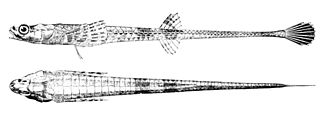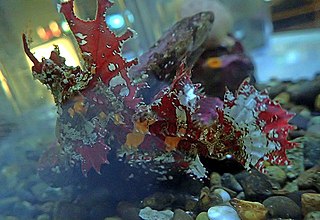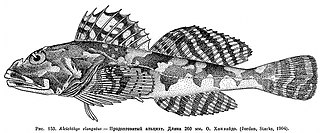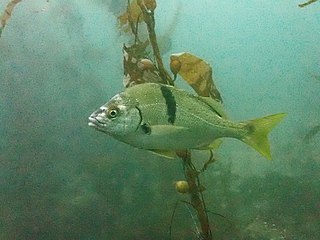
Agonidae is a family of small, bottom-dwelling, cold-water marine fish. Common names for members of this family include poachers, Irish lords, sea ravens, alligatorfishes, starsnouts, hooknoses, and rockheads. They are notable for having elongated bodies covered by scales modified into bony plates, and for using their large pectoral fins to move in short bursts. The family includes about 59 species in some 25 genera, some of which are quite widespread.

Bothragonus is a genus of poachers native to the Pacific Ocean.
Bascanichthys longipinnis is an eel in the family Ophichthidae. It was described by Rudolf Kner and Franz Steindachner in 1867. It is a tropical, marine and brackish water-dwelling eel which is known from the Indian and Pacific Ocean, including India, Sri Lanka, Papua New Guinea, and Samoa.
The short-tooth sawpalate is an eel in the family Serrivomeridae. It was described by Johannes Schmidt in 1916, originally under the genus Leptocephalus. It is a marine, deep water-dwelling eel which is known from the eastern central and western central Atlantic Ocean, including the Bahamas and Bermuda, as well as the Strait of Gibraltar, Cape Verde, Canada and the United States. It dwells at a depth range of 150 to 1,000 metres. Males can reach a maximum total length of 65 centimetres (26 in).
The northern spearnose poacher is a fish in the family Agonidae. It was described by David Starr Jordan and Charles Henry Gilbert in 1880, originally under the genus Agonus. It is a marine, temperate water-dwelling fish which is known from the eastern Pacific Ocean, including southeastern Alaska to southern California, USA. It dwells at a depth range of 0 to 163 metres. Males can reach a maximum total length of 20 centimetres (7.9 in).
The sturgeon poacher is a fish in the family Agonidae. It was described by Wilhelm Gottlieb Tilesius von Tilenau in 1813. It is a marine, temperate water-dwelling fish which is known from the northern Pacific Ocean, including the western Bering Sea, Cape Navarin, the Commander Islands, the Sea of Okhotsk, the Aleutian Islands, and northern California, USA. It dwells at a depth range of 2 to 710 metres, and inhabits soft benthic sediments. Males can reach a maximum total length of 30.5 centimetres (12.0 in).
The longnose poacher is a fish in the family Agonidae. It was described by Charles Henry Gilbert in 1896, originally under the genus Odontopyxis. It is a marine, deep water-dwelling fish which is known from the northern Pacific Ocean, including the Bering Sea, southeastern Alaska, northern Japan, the Sea of Japan and the Sea of Okhotsk. It dwells at a depth range of 20 to 460 metres. Males can reach a maximum total length of 25 centimetres (9.8 in).
the smooth alligatorfish is a fish in the family Agonidae. It was described by Albert Günther in 1860. It is a marine fish which dwells in temperate waters, and is known from the northern Pacific Ocean, including California, USA, and possibly Korea. It dwells at a depth range of 8–102 metres, usually around rocks. Males can reach a maximum total length of 15 centimetres.
The blackfin poacher is a fish in the family Agonidae. It was described by Charles Henry Gilbert in 1890. It is a marine, boreal water-dwelling fish which is known from the northern Pacific Ocean, including Komandorski Island and Avachin Bay in Russia, St. Mathew Island in the Bering Sea, and Eureka, California, USA. It dwells at a depth range of 18–1290 metres, most often at around 400–700 m, and inhabits soft bottoms. It is known to live for a maximum of 9 years. Males can reach a maximum total length of 24.2 centimetres, but more commonly reach a TL of 20 cm.
The bigeye poacher is a fish in the family Agonidae. It was described by Charles Henry Gilbert in 1890. It is a marine, subtropical fish which is known from the Gulf of Alaska to southern California, USA, in the northern Pacific Ocean. It dwells at a depth range of 110–910 metres, and inhabits soft bottoms. Males can reach a maximum total length of 23 centimetres.

The blacktip poacher is a fish in the family Agonidae. It was described by Charles Henry Gilbert in 1890. It is a marine, deep water-dwelling fish which is known from British Columbia, Canada to Baja California, Mexico, in the eastern Pacific Ocean. It dwells at a depth range of 18–400 metres, and inhabits soft benthic sediments. Males can reach a maximum total length of 19 centimetres.
The Stripefin poacher is a fish in the family Agonidae. It was described by Charles Henry Gilbert in 1915. It is a marine, deep water-dwelling fish which is known from the eastern central Pacific Ocean, including southern California, USA; Baja California, Mexico; and an isolated population in the Gulf of California. It dwells at a depth range of 183–366 metres, and inhabits soft benthic sediments. Males can reach a maximum total length of 16 centimetres.

The bluespotted poacher is a fish in the family [Agonidae]]. It was described by Charles Henry Gilbert in 1890, originally in the genus Xenochirus. It is a marine, deep water-dwelling fish which is known from British Columbia, Canada to northern central Baja California, Mexico, in the eastern Pacific Ocean. It dwells at a depth range of 73–373 metres, and inhabits soft benthic sediments. Males can reach a maximum total length of 18 centimetres.

The kelp poacher is a fish in the family Agonidae. It was described by Norman Joseph Wilimovsky and Donald Edward Wilson in 1979, originally under the genus Hypsagonus. It is a marine, temperate water-dwelling fish which is known from northern British Columbia, Canada to central California, USA, in the eastern Pacific Ocean. It dwells at a maximum depth of 11 metres (36 ft), and inhabits shallow, rocky regions. It uses its pectoral fins to climb the faces of rocks and crawl on the bottom. Its body is camouflaged by a coating of sponges and seaweed. Males can reach a maximum total length of 8.9 centimetres (3.5 in).

The fourhorn poacher is a fish in the family Agonidae. It was described by Achille Valenciennes in 1829, originally under the genus Aspidophorus. It is a marine, temperate water-dwelling fish which is known from the northern Pacific Ocean, including the Sea of Okhotsk, the Sea of Japan, the Bering Sea, the Kuril Islands, and Washington, USA. It is non-migratory, and dwells at a depth range of 0 to 452 metres, most often at around 100 to 150 metres. It inhabits sediments of sand and gravel. Males can reach a maximum total length of 12 centimetres (4.7 in), but more commonly reach a TL of 10 centimetres (3.9 in). The maximum recorded weight is 24 grams (0.053 lb), and the maximum recorded age is 7 years.

The dragon poacher is a fish in the family Agonidae. It was described by Peter Simon Pallas in 1769, originally under the genus Cottus. It is a marine, deep water-dwelling fish which is known from the northern Pacific Ocean, including the Sea of Japan, the Sea of Okhotsk, and the Bering Sea. It dwells at a depth range of 19 to 750 metres, and inhabits gravel, sand and mud sediments. Males can reach a maximum total length of 42 centimetres (17 in).

Alcichthys elongatus is a fish in the family Cottidae (sculpins), and the only valid member of its genus. It was described by Franz Steindachner in 1881. It is a marine, boreal fish which is known from the northwestern Pacific Ocean, including the Sea of Okhotsk and Japan. It dwells at a depth range of 15 to 269 m, and inhabits rocky reefs. Males can reach a maximum total length of 44 cm (17 in), but more commonly reach a TL of 31.5 cm (12.4 in). The maximum recorded weight is 1 kg (2.2 lb).
The red sea catfish, also called the long-barbeled sea catfish, is a species of sea catfish in the family Ariidae. It was described by Franz Steindachner in 1876, originally under the genus Aelurichthys. It inhabits tropical marine, brackish and freshwater in the eastern-central and southeastern Pacific regions, including Mexico, Colombia, Ecuador, Costa Rica, Guatemala, Honduras, El Salvador, Panama, Nicaragua, and Peru. It dwells at a maximum depth of 20 m (66 ft). It reaches a maximum total length of 95 cm (37 in), but more commonly reaches 30 cm (12 in).
The sculptured sea catfish is a species of catfish in the family Ariidae. It was described by Franz Steindachner in 1876, originally under the genus Arius. It inhabits brackish and marine waters in Costa Rica, Mexico and Panama. It reaches a maximum total length of 45 cm (18 in), more commonly reaching a TL of 40 cm (16 in).

Anisotremus davidsonii, also known as Xantic sargo, Sargo or Grunt, is a species of grunt native to the eastern Pacific Ocean. They are found from Santa Cruz, California to Baja California, Mexico, with an isolated population located in the Gulf of California.








